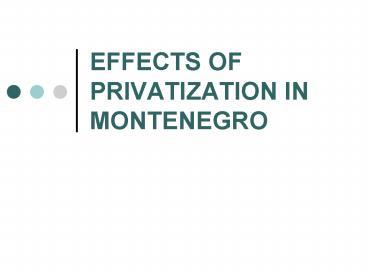EFFECTS OF PRIVATIZATION IN MONTENEGRO - PowerPoint PPT Presentation
1 / 15
Title:
EFFECTS OF PRIVATIZATION IN MONTENEGRO
Description:
EFFECTS OF PRIVATIZATION IN MONTENEGRO. Analysis of post-privatization ... crucially depends on firms' investment in fixed (buildings, equipment) and soft' ... – PowerPoint PPT presentation
Number of Views:32
Avg rating:3.0/5.0
Title: EFFECTS OF PRIVATIZATION IN MONTENEGRO
1
EFFECTS OF PRIVATIZATION IN MONTENEGRO
2
AIM
- Analysis of post-privatization restructuring of
Montenegro firms in the framework that followed
the original contribution of Roland (1996 2000)
and was applied also in the study of
restructuring of Slovenian firms (Domadenik et
al., 2008). - Restructuring process of transition firm into two
stages - defensive (cost-related) restructuring
- deals with loss-making activities,
- provides an answer to a question of how fast the
firms adjust number of employees with respect to
changes in wages and sales - strategic (revenue-focused) restructuring
- includes investment in developing firms main
capabilities to gain comparative advantages - crucially depends on firms investment in fixed
(buildings, equipment) and soft capital
(research and development, marketing, management,
human resources).
3
DATA
- questionnaires, supplemented by secondary data
that we collected from the central bank and from
central depositary agency. - 120 firms
- 60 MVP firms (in year 2000 225 MVP, in year
2008 127) public firms - KAP cluster firms
- Other public firms
- 60 de-novo firms
- Received financiral support from Development Fund
- Other private firms
4
Sample size distribution
5
RESULT 1- the period of growth
- real value added per employee ?
- companies can each year distribute more funds for
wages and profits and hence set more money in
order to finance growth by internal funds, - share of revenues in foreign markets ?
- companies are putting more emphasize on foreign
markets. - improvements are marginal and can not be
characterized as stable - companies that have less than 25 of ownership of
government or government funds invest much bigger
share of their revenues in strategic
restructuring as companies in which government
has (directly or indirectly) more that 25 of
ownership. - privatization process in Montenegro after year
2002 was successful since it leads to the growth
of average company in both company types
6
RESULT 2 rent seeking behavior
- PUBLIC FIRMS
- many companies that were in year 2000 set for MVP
are not observed any more in year 2008 (225 firms
?127 firms reason-liquidation, bankrupcy) - KAP cluster productivity increases were in a
large degree due to the low price of electricity - rents sharedworkers (higher wages), new owners
of KAP (price E ? ? dispute) - PRIVATE FIRMS
- those that obtain loans from the Development Fund
are less successful as the other private firms. - did the more favorable conditions gained the
proper companies
7
RESULT 3 corporate governance
- fast concentration of ownership and control ?
insider corporate governance - How to protect minority shareholders ?
Ownership structure change in year 2002 and 2007
Ownership concentration in Montenegro in public
companies
8
RESULT 3 corporate governance
- concentration of ownership also in private
limited firms. - increased ownership of foreign investors.
- either a result of strategic partnership with
foreign company or the sale of company to the
foreigners.
9
RESULT 4 high replacement rates
- more than once in one year, mainly occurring from
inside. - replacements occur less often in public
joint-stock companies that have better business
results ? mechanisem is not inefficient
Chairman and CEO turnover in period 2002-07
10
RESULT defensive restructuring
11
RESULT strategic restructuring
Investment in strategic restructuring in private
and public firms in the period of 2002-2007 (in
percentage of total revenues)
12
RESULTS LC/employee
13
RESULT restructuring (public firms)
- ? employees (defensive restructuring)?growth of
the productivity - KAP cluster more productive as the other public
joint-stock companies and on average also employ
more workers. - strategic restructuring based mainly on
investment in physical capital, while there is
almost no investment (with few exceptions) in
soft capital.
14
RESULTS restructuring (private firms)
- ?employment
- government aggravated unofficial hiring in these
companies. - once they discover business opportunities that
result in the growth of revenues, they employ,
with certain delay, new workers in order to do
works - larger stress to investment in soft capital (RD,
marketing, education). - reflects their larger market oriented attitude,
although it is possible to object to this in a
certain degree, because they are achieving larger
share of their sales (compared to public
joint-stock companies) on domestic market.
15
CONCLUSION
- What to do with the companies in KAP cluster and
with other public joint-stock companies? - What is appropriate speed of the future
privatization process with respect to the
protection of the minority shareholders in other
public joint-stock companies and also with
respect to the other government property? - case by case approach
- professionally managed
- transparent
- subjected to public social judgment.































